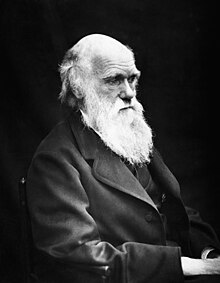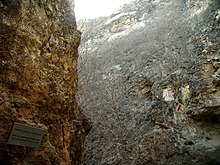From Wikipedia, the free encyclopedia
Paleoanthropology (English: Palaeoanthropology; from Greek: παλαιός (palaeos) "old, ancient"), anthrōpos (ἄνθρωπος), "man", understood to mean humanity, and -logia (-λογία), "discourse" or "study"), which combines the disciplines of paleontology and physical anthropology, is the study of ancient humans as found in fossil hominid evidence such as petrifacted bones and footprints.
History of paleoanthropology
18th Century
Since the time of Carl Linnaeus, the great apes were considered the closest relatives of human beings, based on morphological similarity. In the 19th century, it was speculated that the closest living relatives to humans were chimpanzees and gorillas, and based on the natural range of these creatures, it was surmised that humans shared a common ancestor with African apes and that fossils of these ancestors would ultimately be found in Africa.[1]19th century
The science arguably began in the late 19th century when important discoveries occurred that led to the study of human evolution. The discovery of the Neanderthal in Germany, Thomas Huxley's Evidence as to Man's Place in Nature, and Charles Darwin's The Descent of Man were all important to early paleoanthropological research.
The modern field of paleoanthropology began in the 19th century with the discovery of "Neanderthal man" (the eponymous skeleton was found in 1856, but there had been finds elsewhere since 1830), and with evidence of so-called cave men. The idea that humans are similar to certain great apes had been obvious to people for some time, but the idea of the biological evolution of species in general was not legitimized until after Charles Darwin published On the Origin of Species in 1859.
Though Darwin's first book on evolution did not address the specific question of human evolution—"light will be thrown on the origin of man and his history," was all Darwin wrote on the subject—the implications of evolutionary theory were clear to contemporary readers.
Debates between Thomas Huxley and Richard Owen focused on the idea of human evolution. Huxley convincingly illustrated many of the similarities and differences between humans and apes in his 1863 book Evidence as to Man's Place in Nature. By the time Darwin published his own book on the subject, Descent of Man, it was already a well-known interpretation of his theory—and the interpretation which made the theory highly controversial. Even many of Darwin's original supporters (such as Alfred Russel Wallace and Charles Lyell) balked at the idea that human beings could have evolved their apparently boundless mental capacities and moral sensibilities through natural selection.
Asia
Prior to today's general acceptance of Africa as the root of genus Homo, 19th century naturalists sought the origin of man in Asia. So-called "dragon bones" (fossil bones and teeth) from Chinese apothecary shops were known, but it was not until the early 20th century that German paleontologist, Max Schlosser, first described a single human tooth from Beijing. Although Schlosser (1903) was very cautious, identifying the tooth only as “?Anthropoide g. et sp. indet?,” he was hopeful that future work would discover a new anthropoid in China.Eleven years later, the Swedish geologist Johan Gunnar Andersson was sent to China as a mining advisor and soon developed an interest in “dragon bones”. It was he who, in 1918, discovered the sites around Zhoukoudian, a village about 50 kilometers southwest of Beijing. However, because of the sparse nature of the initial finds, the site was abandoned.
Work did not resume until 1921, when the Austrian paleontologist, Otto Zdansky, fresh with his doctoral degree from Vienna, came to Beijing to work for Andersson. Zdansky conducted short-term excavations at Locality 1 in 1921 and 1923, and recovered only two teeth of significance (one premolar and one molar) that he subsequently described, cautiously, as “?Homo sp.” (Zdansky, 1927). With that done, Zdansky returned to Austria and suspended all fieldwork.
News of the fossil hominin teeth delighted the scientific community in Beijing, and plans for developing a larger, more systematic project at Zhoukoudian were soon formulated. At the epicenter of excitement was Davidson Black, a Canadian-born anatomist working at Peking Union Medical College. Black shared Andersson’s interest, as well as his view that central Asia was a promising home for early humankind. In late 1926, Black submitted a proposal to the Rockefeller Foundation seeking financial support for systematic excavation at Zhoukoudian and the establishment of an institute for the study of human biology in China.
The Zhoukoudian Project came into existence in the spring of 1927, and two years later, the Cenozoic Research Laboratory of the Geological Survey of China was formally established. Being the first institution of its kind, the Cenozoic Laboratory opened up new avenues for the study of paleogeology and paleontology in China. The Laboratory was the precursor of the Institute of Vertebrate Paleontology and Paleoanthropology (IVPP) of the Chinese Academy of Science, which took its modern form after 1949.
The first of the major project finds are attributed to the young Swedish paleontologist, Anders Birger Bohlin, then serving as the field advisor at Zhoukoudian. He recovered a left lower molar that Black (1927) identified as unmistakably human (it compared favorably to the previous find made by Zdansky), and subsequently coined it Sinanthropus pekinensis.[2] The news was at first met with skepticism, and many scholars had reservations that a single tooth was sufficient to justify the naming of a new type of early hominin. Yet within a little more than two years, in the winter of 1929, Pei Wenzhong, then the field director at Zhoukoudian, unearthed the first complete calvaria of Peking Man. Twenty-seven years after Schlosser’s initial description, the antiquity of early humans in East Asia was no longer a speculation, but a reality.
Excavations continued at the site and remained fruitful until the outbreak of the Second Sino-Japanese War in 1937. The decade-long research yielded a wealth of faunal and lithic materials, as well as hominin fossils. These included 5 more complete calvaria, 9 large cranial fragments, 6 facial fragments, 14 partial mandibles, 147 isolated teeth, and 11 postcranial elements—estimated to represent as least 40 individuals. Evidence of fire, marked by ash lenses and burned bones and stones, were apparently also present,[3] although recent studies have challenged this view.[4][5] Franz Weidenreich came to Beijing soon after Black’s untimely death in 1934, and took charge of the study of the hominin specimens.
Following the loss of the Peking Man materials in late 1941, scientific endeavors at Zhoukoudian slowed, primarily because of lack of funding. Frantic search for the missing fossils took place, and continued well into the 1950s. After the establishment of the People’s Republic of China in 1949, excavations resumed at Zhoukoudian. But with political instability and social unrest brewing in China, beginning in 1966, and major discoveries at Olduvai Gorge and East Turkana (Koobi Fora), the paleoanthropological spotlight shifted westward to East Africa. Although China re-opened its doors to the West in the late 1970s, national policy calling for self-reliance, coupled with a widened language barrier, thwarted all the possibilities of renewed scientific relationships. Indeed, Harvard anthropologist K. C. Chang noted, “international collaboration (in developing nations very often a disguise for Western domination) became a thing of the past” (1977: 139).
Africa
In South Africa, a notable and rare find came to light in 1924. In a limestone quarry at Taung, Professor Raymond Dart discovered a remarkably well-preserved juvenile specimen (face and brain endocast), which he named Australopithecus africanus. (Australopithecus = Southern Ape). Although the brain was small (410 cm³), its shape was rounded, unlike that of chimpanzees and gorillas, and more like a modern human brain. In addition, the specimen exhibited short canine teeth, and the foramen magnum was more anteriorly placed, suggesting a bipedal mode of locomotion.
All of these traits convinced Dart that the Taung child was a bipedal human ancestor, a transitional form between ape and man. Another 20 years passed before Dart's claims were taken seriously, following the discovery of additional australopith fossils in Africa that resembled his specimen. The prevailing view of the time was that a large brain evolved before bipedality. It was thought that intelligence on par with modern humans was a prerequisite to bipedalism.
The factors that drove human evolution are still the subject of controversy. Dart's savanna hypothesis suggested that bipedalism was caused by a move to the savanna for hunting. However recent evidence suggests that bipedalism existed before the savannas.[6] Several anthropologists, such as Bernard Wood, Kevin Hunt and Philip Tobias, have pronounced the savanna theory defunct. The aquatic ape hypothesis, developed in response to the perceived flaws of the savanna hypothesis, suggests that wading, swimming and diving for food exerted a strong evolutionary effect on the ancestors of the genus Homo and is in part responsible for the split between the common ancestors of humans and other great apes. It is not well accepted by most researchers in paleoanthropology.[7]
Today, the australopiths are considered to be the last common ancestors leading to genus Homo, the group to which modern humans belong. Both australopiths and Homo sapiens are part of the tribe Hominini, but recent morphological data have brought into doubt the position of A. africanus as a direct ancestor of modern humans.
The australopiths were originally grouped based on size as either gracile or robust. The robust variety of Australopithecus has since been renamed Paranthropus (P. robustus from South Africa, and P. boisei and P. aethiopicus from East Africa). In the 1930s, when the robust specimens were first described by Robert Broom, the Paranthropus genus was used. During the 1960s, the robust variety was moved into Australopithecus. The recent consensus has been to return to the original classification as a separate genus.
The real hub of palaeoanthropological activity was in eastern Africa at the famous Olduvai Gorge, Tanzania. The Leakey family became a name associated with human origins, particularly the search for the first human.
In 1975, Colin Groves and Vratislav Mazák announced a new species of human they called Homo ergaster.
Ian Tattersall once noted (Nature 2006, 441:155) that paleoanthropology is distinguished as the "branch of science [that] keeps its primary data secret."
Renowned paleoanthropologists
- Robert Ardrey (1908–1980)
- Lee Berger (1965 - )
- Davidson Black (1884–1934)
- Robert Broom (1866–1951)
- Michel Brunet (1940 - )
- J. Desmond Clark (1916–2002)
- Carleton S. Coon (1904–1981)
- Raymond Dart (1893–1988)
- Eugene Dubois (1858–1940)
- Johann Carl Fuhlrott (1803–1877)
- Aleš Hrdlička (1869-1943)
- Glynn Isaac (1937–1985)
- Donald C. Johanson (1943- )
- Kamoya Kimeu (1940- )
- Gustav Heinrich Ralph von Koenigswald (1902–1982)
- Jeffrey Laitman (1951- )
- Louis Leakey (1903–1972)
- Meave Leakey (1942- )
- Mary Leakey (1913–1996)
- Richard Leakey (1944- )
- André Leroi-Gourhan (1911–1986)
- Kenneth Oakley (1911–1981)
- David Pilbeam (1940-)
- John T. Robinson (1923–2001)
- Jeffrey H. Schwartz (1948-)
- Chris Stringer (1947- )
- Ian Tattersall (1945- )
- Pierre Teilhard de Chardin (1881–1955)
- Phillip V. Tobias (1925-2012)
- Erik Trinkaus (1948-)
- Alan Walker (1938-)
- Franz Weidenreich (1873–1948)
- Milford H. Wolpoff (1942- )
- Tim D. White (1950- )
 |




